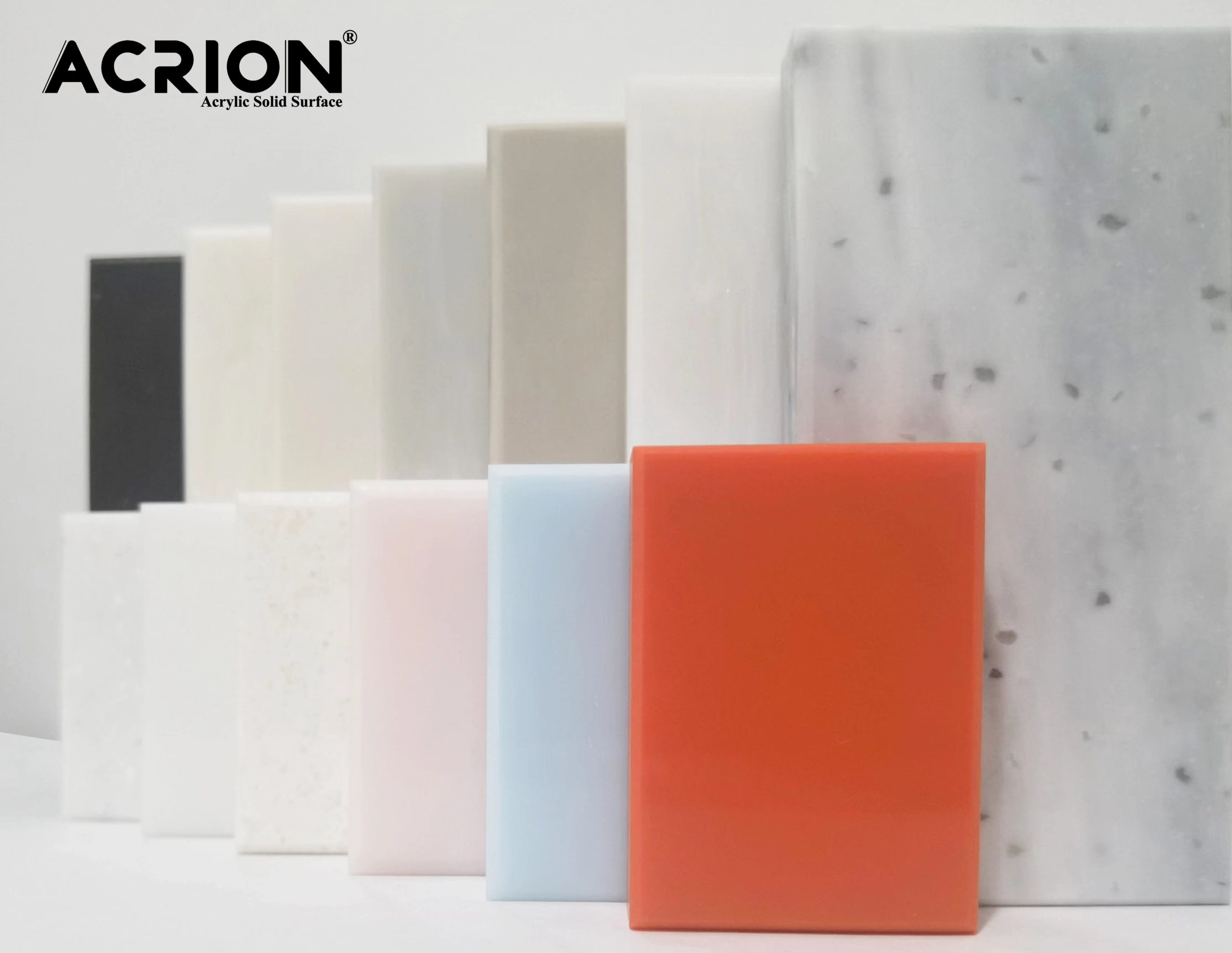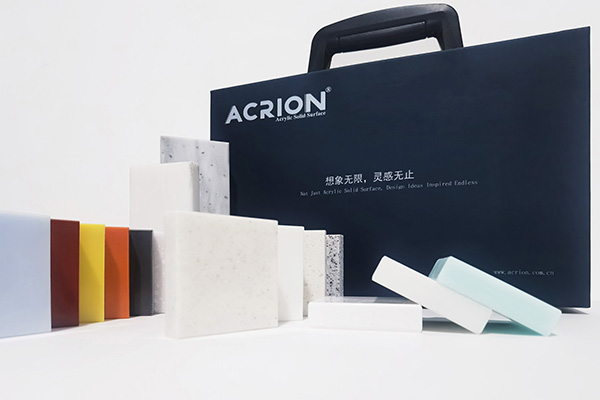การวิเคราะห์ประสิทธิภาพการต้านทานอุณหภูมิต่ำของพื้นผิวที่เป็นของแข็งอะคริลิคควรดำเนินการจากสามมิติ: โครงสร้างวัสดุการตอบสนองทางกลและการปฏิสัมพันธ์ทางสิ่งแวดล้อมและการประเมินที่ครอบคลุมควรดำเนินการร่วมกับการทดสอบในห้องปฏิบัติการและสถานการณ์การใช้งานจริง การวิเคราะห์ต่อไปนี้ดำเนินการจากสามด้าน: ตัวบ่งชี้ประสิทธิภาพที่สำคัญวิธีการทดสอบและกลไกความล้มเหลว:
ขั้นแรกการเปลี่ยนแปลงคุณสมบัติทางกายภาพในสภาพแวดล้อมที่อุณหภูมิต่ำ
อิทธิพลของอุณหภูมิการเปลี่ยนแก้ว (TG)
TG ของอะคริลิคเรซินมักจะอยู่ระหว่าง 0 ℃ถึง 50 ℃ เมื่ออุณหภูมิแวดล้อมต่ำกว่า TG การเคลือบจะเปลี่ยนจากสถานะที่ยืดหยุ่นสูงเป็นสถานะแก้วและความสามารถในการเคลื่อนไหวของโซ่โมเลกุลจะลดลงอย่างมีนัยสำคัญ ตัวอย่างเช่นการเคลือบที่มี TG 10 ℃อาจมีความยืดหยุ่นลดลงมากกว่า 50% ในสภาพแวดล้อม -10 ℃ส่งผลให้ความต้านทานต่อแรงกระแทกลดลง
ปรากฏการณ์ embrittlement อุณหภูมิต่ำ
Brittle fracture may occur in the coating within the range of -30℃ to -50℃. สามารถสังเกตได้ผ่านการทดสอบผลกระทบของรอยว่าการเคลือบด้วยการแตกหักแบบดัดที่อุณหภูมิห้องเปลี่ยนเป็นการแตกหักแบบเปราะที่อุณหภูมิต่ำและหน้าตัดที่แสดงลักษณะคล้ายกระจกแสดงให้เห็นว่าพลังงานการแพร่กระจายของรอยแตกลดลงอย่างมีนัยสำคัญ
Accumulation of contraction stress
Low temperature causes the volume of the coating to shrink. If the thermal expansion coefficient does not match that of the substrate, it may trigger interfacial stress. ตัวอย่างเช่นความแตกต่างของอัตราการหดตัวระหว่างการเคลือบและสารตั้งต้นโลหะอาจถึง 0.5% ที่ -20 ℃ส่งผลให้การยึดเกาะหรือการเคลือบลดลงลดลง
ประการที่สองวิธีการทดสอบสำหรับประสิทธิภาพอุณหภูมิต่ำ
การทดสอบอุณหภูมิอุณหภูมิอุณหภูมิต่ำ
ตามมาตรฐาน GB/T 5470-2008 ตัวอย่างการเคลือบถูกวางไว้ในการติดตั้งที่เย็นลงด้วยไนโตรเจนเหลวและเย็นลงในอัตรา 2 ℃/นาที อุณหภูมิที่บันทึกการเคลือบจะถูกบันทึกไว้ อุณหภูมิ embrittlement ของการเคลือบอะคริลิคทั่วไปอยู่ระหว่าง -40 ℃และ -60 ℃ ต่ำกว่าอุณหภูมินี้การเคลือบผิวมีแนวโน้มที่จะเกิดความเสียหายอย่างรุนแรง
การทดสอบการดัดอุณหภูมิต่ำ
หลังจากเก็บตัวอย่างที่เคลือบไว้ที่ -20 ℃, -40 ℃และ -60 ℃เป็นเวลา 2 ชั่วโมงให้ทำการทดสอบการดัด 180 °ทันที สังเกตว่ามีรอยแตกหรือลอกบนพื้นผิวของการเคลือบ ตัวอย่างเช่นเมื่อรัศมีการดัดงอน้อยกว่า 5 มม. ที่ -40 ℃การเคลือบอาจพัฒนา microcracks ในระดับ 0.1 มม.
การทดสอบการยึดเกาะอุณหภูมิต่ำ
หลังจากได้รับการบำรุงรักษาที่อุณหภูมิที่ตั้งไว้เป็นเวลา 30 นาทีการยึดเกาะจะถูกประเมินโดยวิธีกริด ตัวอย่างเช่นการเคลือบที่มีการยึดเกาะเกรด 0 ที่อุณหภูมิห้องอาจลดลงถึงเกรด 2 ที่ -30 ℃ซึ่งบ่งชี้ว่าอุณหภูมิต่ำนำไปสู่การลดลงของแรงพันธะอินเตอร์เซียล
การทดสอบการขี่จักรยานอุณหภูมิต่ำ
เพื่อจำลองความแตกต่างของอุณหภูมิระหว่างกลางวันและกลางคืนตัวอย่างการเคลือบจะอยู่ภายใต้วัฏจักรเย็นและร้อน 100 รอบภายในช่วง -40 ℃ถึง 20 ℃โดยแต่ละรอบยาวนาน 2 ชั่วโมง สังเกตว่าการเคลือบแสดงให้เห็นว่าผงเดือดหรือปอกเปลือกและประเมินความต้านทานต่อสภาพอากาศในระยะยาว
ประการที่สามกลไกความล้มเหลวในสภาพแวดล้อมที่อุณหภูมิต่ำ
การแตกที่เกิดจากความเครียดภายใน
การหดตัวอุณหภูมิต่ำทำให้เกิดความเครียดแรงดึงภายในการเคลือบ เมื่อความเครียดเกินความต้านทานแรงดึงของการเคลือบมันอาจทำให้เกิดรอยแตกตั้งฉากกับพื้นผิว ตัวอย่างเช่นการเคลือบที่มีความหนา100μmอาจทำให้เกิดรอยแตกรัศมีกว้าง 0.2 มม. ที่ -50 ℃
อินเทอร์เฟซ debonding
หากการยึดเกาะระหว่างการเคลือบและสารตั้งต้นนั้นไม่เพียงพอการหดตัวอุณหภูมิต่ำอาจทำให้เกิดการลอกส่วนต่อประสาน สามารถสังเกตได้ผ่าน SEM ว่าส่วนตัดของการเคลือบที่ได้รับการรักษาที่ -30 ℃แสดงการแยก interlayer ที่ชัดเจนและสารตกค้างที่ส่วนต่อประสานจะลดลง
การแยกไมโครโฟนทวีความรุนแรงมากขึ้น
ที่อุณหภูมิต่ำความเข้ากันได้ระหว่างส่วนที่อ่อนนุ่มและแข็งในอะคริลิคเรซินลดลงซึ่งอาจนำไปสู่การแยกไมโครเฟส ตัวอย่างเช่นโคพอลิเมอร์ที่มีความแตกต่างอย่างมีนัยสำคัญใน TG อาจแสดงโครงสร้างการแยกเฟสที่ระดับ5-10μmที่ -20 ° C ซึ่งมีผลต่อความสม่ำเสมอของการเคลือบ
ประการที่สี่การตรวจสอบสถานการณ์แอปพลิเคชันจริง
ผนังด้านนอกของอาคารในภูมิภาคที่หนาวเย็นมาก
ในสภาพแวดล้อมที่ -40 ℃ความต้านทานของการเคลือบจะต้องตรวจสอบวัฏจักรการแช่แข็ง ตัวอย่างเช่นแช่ตัวอย่างเคลือบในน้ำและแช่แข็งที่ -40 ℃จากนั้นโอนไปที่ 20 ℃สำหรับการละลาย ทำซ้ำ 50 ครั้งและสังเกตว่าการเคลือบปิดหรือไม่
อุปกรณ์ขนส่งโซ่เย็น
สำหรับสภาพแวดล้อมการจัดเก็บเย็นตั้งแต่ -25 ℃ถึง -18 ℃จำเป็นต้องทดสอบความต้านทานการกัดกร่อนของการเคลือบภายใต้สภาพอุณหภูมิต่ำและความร้อนสูง ตัวอย่างเช่นหลังจากการเคลือบได้รับการบำรุงรักษาที่ -20 ℃และ 90%RH เป็นเวลา 72 ชั่วโมงไม่ว่าจะเป็นน้ำค้างแข็งสีขาวหรือสนิมปรากฏบนพื้นผิว
การเคลือบอุปกรณ์ขั้วโลก
Under extremely cold conditions of -60℃, the impact resistance of the coating needs to be evaluated. For example, a drop hammer impact test was adopted. The coating was impacted at -60℃ with an energy of 1J, and it was recorded whether visible cracks occurred.
Fifth, performance optimization direction
Molecular structure design
The introduction of flexible segments (such as butyl acrylate) can reduce Tg and improve low-temperature toughness. ตัวอย่างเช่น copolymerizing ethyl acrylate ด้วย butyl acrylate สามารถลด TG จาก 20 ℃เป็น -10 ℃การปรับปรุงประสิทธิภาพที่อุณหภูมิต่ำอย่างมีนัยสำคัญ
Crosslinking density regulation
การเชื่อมขวางในระดับปานกลางสามารถเพิ่มความแข็งแรงของการเคลือบได้ แต่การเชื่อมขวางที่มากเกินไปจะช่วยลดความยืดหยุ่น ตัวอย่างเช่นโดยการปรับปริมาณของสารเชื่อมขวางอุณหภูมิ embrittlement อุณหภูมิต่ำสามารถลดลงได้ 10 ℃ในขณะที่รักษาความแข็ง
การปรับเปลี่ยนฟิลเลอร์
การเพิ่มฟิลเลอร์ระดับนาโน (เช่นซิลิกาควัน) สามารถยับยั้งการแพร่กระจายของรอยแตก ตัวอย่างเช่นการเพิ่ม 5% นาโนฟิลเลอร์สามารถเพิ่มการยืดตัวเมื่อหยุดการเคลือบ 20% ที่ -40 ℃



